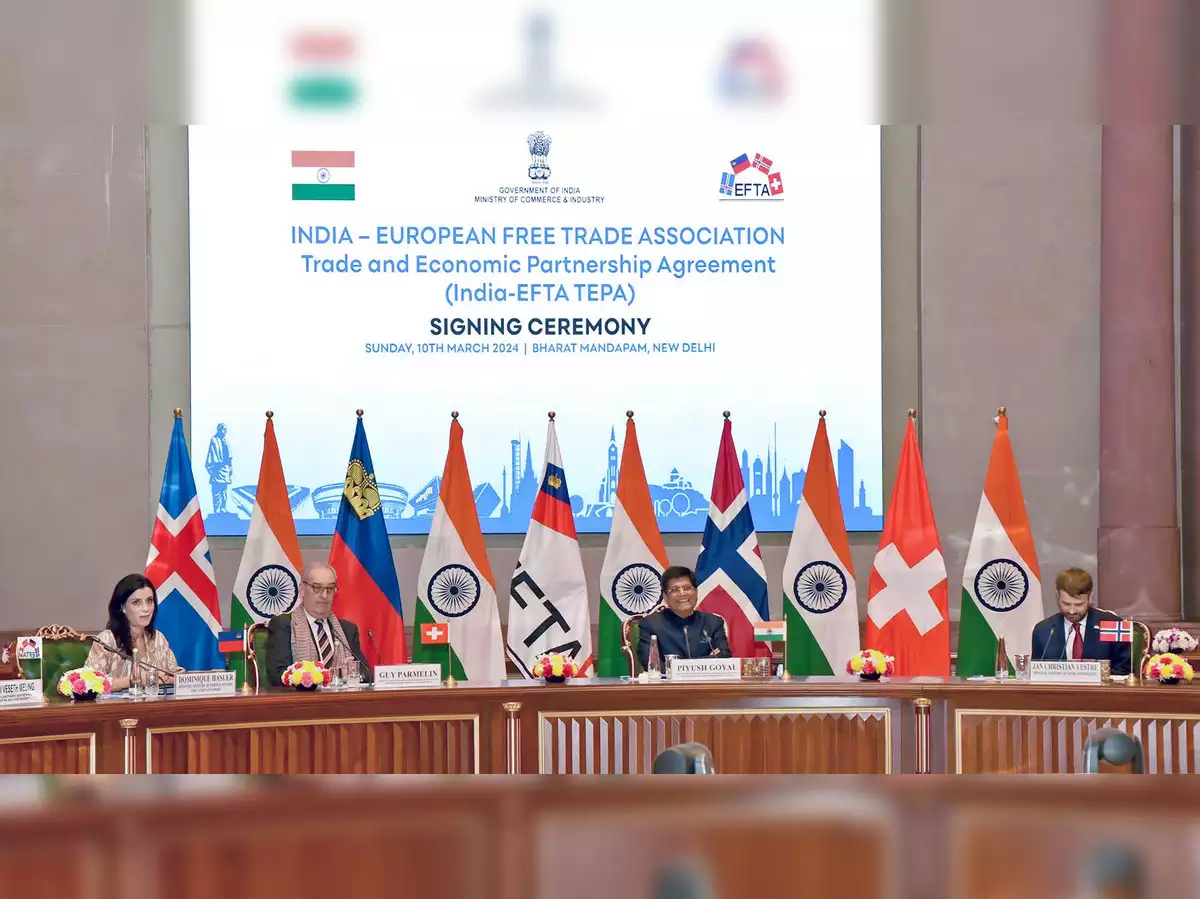India, on Sunday 10th March 2024, signed TEPA (Trade & Economic Partnership Agreement), a free trade agreement with EFTA, a four-countries European block. In the long-term, this FTA will benefit both India & EFTA countries. With this Trade agreement, India has assured a guarantee of 100 Billion USD investments. This is truly a historical & Watershed moment, as India has for the first time signed a Free Trade agreement with a western country.
Let’s first read what India’s Minister of Commerce and Industry, Shree Piyush Goyal has to say about this agreement to understand its importance.
“It’s for the first time in the history of the world that we are inking a free trade agreement with a binding commitment to invest 100 Billion USD in India from the EFTA countries on the back of solid foundations that have been laid in India with strong macroeconomic fundamentals.”
India’s Minister of Commerce and Industry, Shree Piyush Goyal
India-EFTA Trade Deal to Bring in $100 Billion USD in 15 years
In this agreement, India put a condition with these four nations for India’s open market access. These countries need to invest almost 100 Billion USD in the next 15 years. Apart from it, Indian businesses also got free access to EFTA countries’ markets. EFTA (European Free Trade Agreement) is a block of four countries i.e., Iceland, Liechtenstein, Norway & Switzerland. Previously this group also contained some other European countries like Sweden, but currently only these four important countries exist in this block.
Why did India sign TEPA only with EFTA countries, not the whole European Union?
One of the most important questions that came into our mind after getting this news is why India didn’t sign a free trade agreement with the whole European Union. Well, you need to understand that these four countries are part of Europe’s Schengen Zone, but do not accept the Euro as their currency. EFTA countries are also not members of the European Custom Association. When it comes to the terms of Trade & economics, these countries have a completely different system compared to the rest of the European Union members.
Iceland currency is Icelandic Króna, Norway currency is Norwegian Krone, while Liechtenstein & Switzerland currency is Swiss Franc. So, India signed a free trade agreement with these countries separately after 16 years of negotiations. Meanwhile, the negotiations of India’s Free Trade agreement with the European Union is still underway.
When we talk about the current trade between India & EFTA countries, then India’s Export stood at $1.92 Billion during 2022-23. India has a trade deficit with this block, with a huge import bill of $16.74 billion last year. The largest trading partner of this block with India is Switzerland, followed by Norway.
Key Components of India-EFTA Free Trade Agreement
After this agreement, Indians can enjoy cheaper high-quality products from Switzerland like Watches, Clocks, Coffee, Chocolates, Biscuits, etc. India will start the process of phasing out custom duties on all these goods in the next 10 years. Apart from this, these countries also gain more smooth access to India’s Service sector like accounting, business, computer, health, distribution etc. Norway has secured commitments in 114 sub-sectors including software, hardware, etc. In total, Switzerland has secured commitments in 128 sub-sectors, Liechtenstein in 107 & Iceland in 110.
Indian exports will also boost in segments like pharmaceuticals & health-related products, textile & cloths, etc. with 98% less tariff. Indian services like legal, computer, R&D, accounting auditing are also covered in this agreement. The main concern of India related to generic medicine & patents also got covered in this trade agreement. So overall, this is a very good trade deal between both countries.
TEPA & $100 Billion Legal Commitment – What if NOT Fulfilled?
This agreement insures a total investment of $100 Billion, divided into two parts. After the implementation of this agreement, EFTA needs to invest 50 Billion USD in the first 10 years, while the rest 50 Billion USD in next five years. These investments will come through private players & help to directly generate 1 Million jobs in India.
If this $100 Billion commitment is not fulfilled, then this agreement has a provision to ‘re-balance or suspend’ the custom duties as an outcome of this agreement.
In Conclusion, it is understood that India has put some really tough negotiations before finalizing this deal. Also, India has set a template for the upcoming trade agreements with other countries. If these countries want open access to India’s huge market, then they need to pledge some investments. It will help India in creating new jobs for the rising skilled population.

